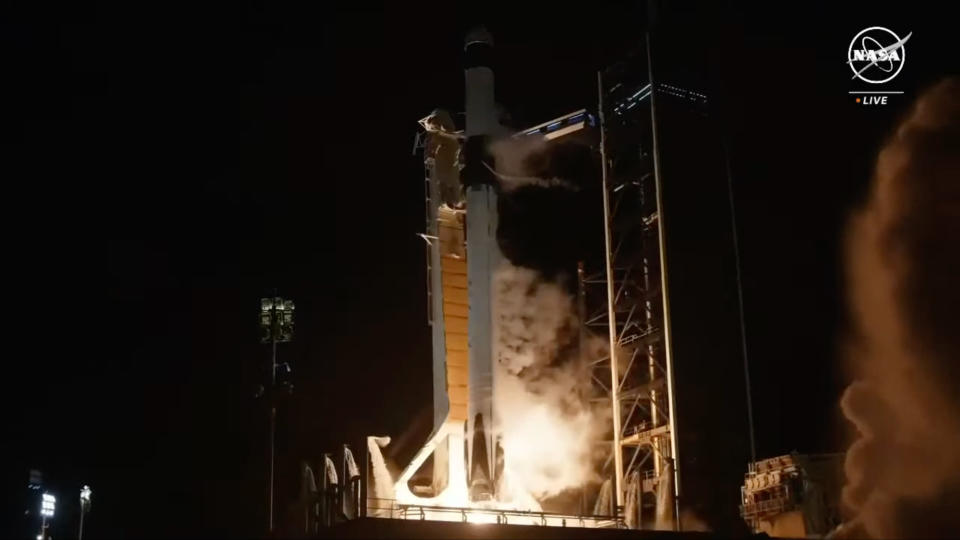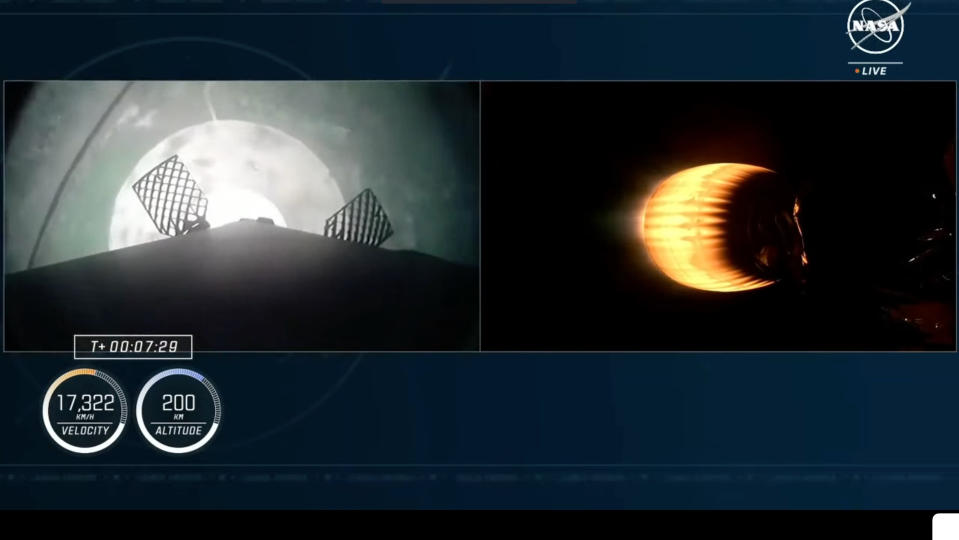SpaceX launched another crew of four to the International Space Station this evening (March 3).
A SpaceX Falcon 9 rocket lifted off tonight at 10:53 PM EST (0353 GMT on March 4) carrying the four astronauts of NASA’s Crew-8 mission from Pad 39A at the Kennedy Space Center (KSC) in Cape Canaveral, Florida .
The two stages of the rocket separated 2.5 minutes after launch. About five minutes later, the first stage returned to Earth at Cape Canaveral, making the company’s 204th consecutive booster landing. Then, 12 minutes and 15 seconds after liftoff, the Falcon 9 upper stage placed the mission’s Crew Dragon capsule, named Endeavor, into low Earth orbit (LEO).
The Crew-8 astronauts now en route to the space station are Matthew Dominick (commander), Michael Barratt (pilot) and Jeanette Epps (mission specialist) from NASA, as well as mission specialist Alexander Grebenkin from the Russian space agency Roscosmos. All crew members are new to space except Barratt, who is on his third space flight.
“Hey, Earth! Just so you know, it’s kind of like a roller coaster ride with a bunch of really excited teenagers,” Barratt told mission control shortly after Endeavor deployed to LEO. “Thank you to our friends and colleagues at SpaceX for the amazing ride. It’s great to be back in space!”
Related: Meet the SpaceX Crew-8 astronauts launching to the ISS

Crew-8 marks SpaceX’s 13th crewed flight overall and the eighth operational flight for NASA as part of the agency’s Commercial Crew Program. The company has now sent a total of 50 people to orbit.
Tonight’s launch marked the first flight of this particular Falcon 9 rocket, making it the sixth time SpaceX has used an unflown rocket in a crewed launch.
On the other hand, the Endeavor capsule is a seasoned veteran. Endeavor flew on the first crewed test flight of the Crew Dragon spacecraft on May 30, 2020, carrying NASA astronauts Bob Behnken and Doug Hurley to the ISS.
Since then, Endeavor has also flown the Crew-2 and Crew-6 missions for NASA in 2022 and the Ax-1 private mission for Houston-based company Axiom Space. Crew-8 therefore marks five flights for Endeavor, the most of any crew member. Dragon, making it the “fleet leader,” said Steve Stich, manager of NASA’s Commercial Crew Program, during a Feb. 28 news conference at KSC.
But despite the number of times these capsules have been flown — in addition to the increasing rate at which SpaceX is launching crewed missions to the orbital laboratory — NASA refuses to let its guard down. During the same Feb. 28 briefing, NASA Administrator Bill Nelson emphasized that crew safety is “primary” for the agency. “It’s a risky business,” he said.
“Every time we launch, it’s time to flex our muscles – and especially when people are at the top,” Nelson added later during the briefing. “We never want to get into the mindset of it being so routine that it’s like getting in your car and going for a drive on a Sunday afternoon.”
That safety culture was on display tonight in the run-up to the launch. Shortly after the four astronauts were locked inside Endeavor, mission team members noticed a small crack in the thermal seal around the capsule’s hatch. After much discussion and analysis, NASA and SpaceX concluded that the problem was minor and would not pose an excessive risk to the crew, so they proceeded with the launch.
“We estimate the square area of this defect to be approximately 0.02 square inches [0.13 square centimeters]That’s less than half of what we need to qualify this system for holes, cracks or other defects,” Sarah Walker, director of Dragon Mission Management at SpaceX, said during a press conference held about an hour after launch. “About 0.05 inches [0.32 square cm]I believe this is the qualifying limit.”
Additionally, the crack will be on the leeward side of Endeavor when it re-enters Earth’s atmosphere in six months, meaning it won’t be exposed to the most extreme heat the capsule experiences. And the sealing material will likely expand during reentry, eliminating the defect anyway, Stich said at the post-launch briefing.


Tonight’s launch took place a few days later than expected; it was postponed several times due to bad weather.
During their six-month stay aboard the ISS, the Crew-8 astronauts will conduct more than 200 scientific experiments and technology demonstrations in the field of microgravity, including research that will support human exploration in deep space.
NASA is already looking to the future with its current human-related scientific research efforts, to a time when humans could live aboard private space stations or fly long-duration missions to the moon and Mars through the agency’s Artemis program.
RELATED STORIES:
– Why NASA astronaut Jeanette Epps waited six extra years for her ISS space mission
— SpaceX Crew-8 astronauts eager to launch to ISS on March 2: ‘It’ll take you by surprise, but we’re ready’
— SpaceX rolls out rocket and capsule to launch Crew-8 astronaut (photos)
Similar to Crew-8’s scientific focus, most of the agency’s current human science research is focused not only on thriving in LEO, but also on keeping human crews safe and healthy during exploration missions, said Kristin Fabre, deputy chief scientist of NASA’s Human Research Program, told Space.com. “The need to understand all the changes that occur during exploration missions, as well as understand the changes of the human body across a diverse population, is more important than ever,” Fabre said.
When the Crew-8 quartet arrives at the space station, they will briefly join the four international astronauts from Crew-7 before the latter group passes the torch and prepares for their departure, which will take place no earlier than March 11. 8 will also meet with the three members of the Russian MS-24 mission, including NASA astronaut Loral O’Hara.
SpaceX is one of two commercial companies with billion-dollar contracts to fly astronauts to the ISS and back for NASA. The other company, Boeing, aims to launch the first crewed flight of its Starliner spacecraft no earlier than April 22.
Editor’s Note: This story was updated on March 4 at 12:55 a.m. ET with more information about the thermal seal failure from the post-launch press conference.